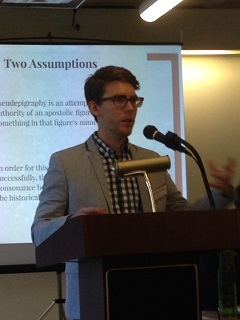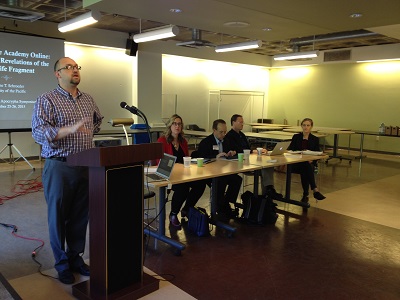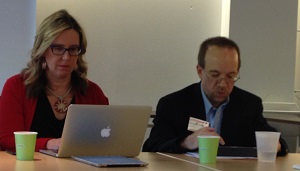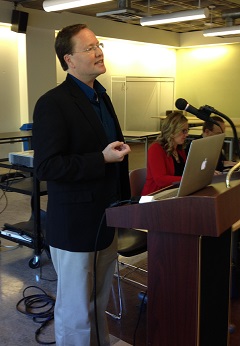2015 York Christian Apocrypha Symposium: A Postmortem (Part 4)
The final day of the Symposium began with a session that was a bit of a grab-bag of papers. Early versions of the program were more cohesive, but with some presenters pulling out, new ones coming in, and the needs of some presenters to leave early or arrive late, we had to make adjustments. We titled the session “Reimagining the Past in Christian Apocrypha,” though, in hindsight, the title is really not very representative of the papers. We tried.

Gregory Fewster (University of Toronto) began the session with “Paul as Letter Writer and the Success of Pseudepigraphy: Constructing an Authorial Paul in the Corinthian Correspondence.” The paper is a response to Alberto D’Anna’s argument that discrepancies between 3 Corinthanians and other Pauline letters “reduces a lot … the possibility of success for the fiction.” But, as Fewster demonstrates, 3 Cor. was successful, so much that it was included in some NT canons, even the occasional Latin codex. It seems that constructing a believable Pauline pseudepigraphon was relatively easy, given that even in the second century Paul was known more for his letter-writing practice than for the contents of his letters. So, despite the discrepancies, Fewster says, “one could thus believe that Paul wrote this response letter because Paul is the type of person who would have written this letter.” One of the strengths of Fewster’s paper is in its attention to the various forms the Corinthian Correspondence takes, both as an independent writing and embedded in the Acts of Paul, and to the various languages in which it is extant. Attention shifted from Paul to Peter in Pamela Mullins Reaves’ (Colorado College) paper “Pseudo-Peter and Persecution: (Counter-) Evaluations of Suffering in Coptic Apocalypse of Peter (NHC VII,3) and The Letter of Peter to Philip (NHC VIII,2).” Mullins Reaves focuses much of her paper on Apoc. Peter, noting how it reflects intra-Christian conflict over suffering. But both works recognize in Peter a figure associated with martyrdom and use him, not as a spokesperson for a particular Christian group or theology, as we have come to expect in apocryphal texts, but as a site for debate over suffering. Something similar occurs in 3 Cor. where Paul is used for articulating views on resurrection.
After a short break, our lone Francophone presenter, Dominique Côté (University of Ottawa) discussed his paper, “In the Name of James and Clement. The Brother of Jesus in the Pseudo-Clementines.” Côté has worked extensively over the years on the Pseudo-Clementines. In this paper he focuses on how the entire novel is presented as a lengthy letter to be sent to James and wonders why it was necessary to use the epistolary motif to circulate the novel. He concludes that James is used in the Pseudo-Clementine Homilies, here seen as being close to the original form of the text, to harmonize Christianity with Judaism. The same motivation is attributed to Rufinus, the Latin translator of the Recognitions, though for different reasons: “to affirm the continuity between the church of Jerusalem, founded by James and appointed bishop by Jesus himself, and the church of Rome, founded by Peter, designated as the foundation of the church by Jesus himself.” Rufinus, however, was intent on showing continuity in church leadership, not on allying Christianity with Jewish thought and praxis.

The morning session concluded with Anne Moore’s (University of Calgary), “‘Days of Our Lives’: Female Friendship/Rivalry In the Christian Apocrypha.” The first three papers were somewhat cohesive, each focusing on a certain pillar of the church and how the figure is used by writers of apocrypha. But Moore’s paper is quite different. It focuses on the Passion of Andrew (the latter section of the Acts of Andrew) and characterizes the text as having a similar setting, plot, and characterization as a modern soap opera. The acts and soaps also share a similar social function. “The [Apocryphal] Acts offer an alternative to the traditional roles of wife and mother,” Moore writes. “Analogously, the soap operas provided women of the 1960s on with an alternative to the traditional role of housewife and mother.” The Passion of Andrew features the type of household typical of soap operas, with characters vying with one another for sexual dalliances and thus threatening the honor of the family. Moore’s paper focuses on the minor characters of the narrative, the slaves Iphidama and Euclia, and how they play out the role-sets expected of them in the Roman domus. Iphidama introduces her mistress Maximilla to Andrew, which leads to the breakdown of the household and the loss of the family’s honor. Euclia is tasked by Maximilla to have sex with her husband Aegeates. Euclia is thus fulfilling one of the roles of a female slave, but the mistress of the house is usually presented in contemporary literature as trying to limit these interactions; instead, Maximilla “is assuming the role of a pimp providing her husband with sexual release.” This could lead to an additional challenge to the family honor: the creation of a non-elite heir. Clearly, Moore’s paper is much different from the others in the session, but this worked to its benefit, as the audience responded to it very positively (I guess that’s what happens when you bring sex into the discussion). The paper became one of the highlights of the Symposium.
As mentioned in my first porst mortem post, the Gospel of Jesus’ Wife panel was one of the two pillars on which our Symposium stood. Given the text’s exposure in the media—during the planning of the event and right up to the days before event itself (fortuitous that!)—it seemed wise to incorporate it into the program as a way to draw in members of the wider public (see my last post on how well that went!). But we wanted to avoid arguments of authenticity, in part because that was the focus of other gatherings on the text and because with a year between planning and mounting the symposium, there was no telling where the discussion on authenticity would go. We decided to focus instead on the reception of the text in scholarship—more specifically the role of bibliobloggers in the study of the text and the conflict generated from Christian Askeland’s infamous “ugly sister-in-law” post.

We assembled the panel with the help of Janet Spittler, who had become involved with the online discussion of Askeland’s post and was eager to take part in the Symposium (she was scheduled in 2013 but had to withdraw). Caroline Schroeder had also been a prominent voice in the wider discussion of the text and, because of her work in the Digital Humanities, we were keen to draw her into the Christian Apocrypha fold. James McGrath is an avid blogger (his output on Exploring Our Matrix is phenomenal) and had brought a more cautious perspective to the authenticity debate in several posts. We asked Anthony Le Donne, author of The Wife of Jesus: Ancient Texts and Modern Scandals, to contribute to the panel with a paper sketching out the broad parameters of the discussion to date, but he was not available. Then, out-of-the-blue Mark Goodacre volunteered a paper on the topic, unaware even of our efforts to assemble a panel. Goodacre’s NTBlog was front and centre in the authenticity debate and he was interested precisely in examining the text’s reception. Our panel was set.
We decided not to distribute drafts of the papers for this session in advance, thinking that it might be more dynamic and immediate if the audience were hearing the presenters’ arguments for the first time. It helped that all four panelists are dynamic speakers. After a brief introduction from Brent Landau, the session began with Caroline Schroeder’s presentation, “Gender and the Academy Online: The Authentic Revelations of the Jesus’ Wife Fragment.” She examined several “markers of authenticity” related to the text, including the privileging of scientific studies of the manuscript over traditional humanistic ones; issues of provenance and the resulting political and ethical ramifications of working with unprovenanced materials; issues of status, gender, and identity and how these affect the academic production of knowledge; and attitudes in the field toward digital scholarship and digital publishing. Schroeder juxtaposed traditional publishing methods (typically slow to release results and employed by higher-status scholars like Karen King through print publications such as Harvard Theological Review) vs. digital publishing/blogging (with speedy dissemination and featuring the voices of independent scholars and scholars at less high-profile institutions). Regarding gender, Schroeder noted that women are discouraged from online scholarship because of intimidation and rape threats and that there are fundamental barriers to the presence of women’s voices in the field, including the problem of the “leaky pipeline” (very few women complete their PhDs). Furthermore, she criticized Harvard University for helping to create the hostile environment surrounding discussion of the text; “Harvard bears no small amount of responsibility in this controversy,” Schroeder said, “for winding it up and exposing King to the resulting maelstrom.” But she criticized King also for agreeing to keep the identity of the owner of the text a secret (though admitting that, in the same position, she may have done the same) and urging scholars to consider carefully the ramifications of working with unprovenanced texts: “As we move forward as a scholarly community, we need to apply self-scrutiny when we use the ‘pursuit of knowledge’ to rationalize what we now know to be ethically murky work.” Schroeder finished with a defense of social media and digital publishing as genuine scholarship and urged female scholars to become more involved online, despite the risks, and called for other scholars, particular senior scholars, to support female colleagues online.

Next up was James McGrath with “Slow Scholarship: Do Bloggers Rush in Where Jesus’ Wife Would Fear to Tread?” McGrath had positive things to say about the speed of online scholarship on GJW and, echoing Schroeder, about how the internet democratizes scholarship by allowing in voices of non-experts. That said, among the 27 bloggers who commented on the text, McGrath was most interested in the number of well-known scholars in the group and called this embrace of digital media “a noteworthy moment in the history of scholarship.” But McGrath also had plenty of criticism of online scholarship. He noted that the consensus that emerged on GJW as a forgery is likely correct, but was wary about the nature of the consensus. First, the bloggers who argued for forgery were right before the evidence was presented to prove it so. “Within three days (and in some cases significantly less),” McGrath said, “there were scholars who felt that they were in a position to comment with confidence on a question pertaining to a papyrus which had not been subjected to scientific testing, and about which experts in papyrology had expressed a range of opinions.” He was not calling for a “slow scholarship movement” but urged bloggers to work “as scholars” using appropriate scholarly methodology: “I am not advocating for us to move more slowly,” he said, “but to move as quickly as we can while still being careful.” McGrath’s second point about the consensus was that it may not be fully representative of the opinions in the field, in part because bloggers “tend to have views that are a minority stance in the guild,” and because “consensus building takes time.” And third, McGrath drew attention once again to the tone of the discussion online; because blog posts are written typically in a more relaxed style than traditional scholarship, snide or offensive remarks slipped into the articles (McGrath cited here Askeland’s “ugly sister-in-law” comparison and Francis Watson’s “homophobic mischaracterization of Secret Mark” in which he describes the Jesus of Secret Mark as liking, in Watson’s words, “to consort naked with young men at night, while seeming hostile to women”).

Mark Goodacre took a step back with his presentation “Jesus’ Wife, the Media and The Da Vinci Code,” looking at the “perfect storm” environment in popular culture that could have given rise to the creation of the GJW. He presented an overview of Mary Magdalene in Jesus films, noting a significant change in her portrayal after the publication of Dan Brown’s The Da Vinci Code in 2003—going from a prostitute to a prominent disciple. Goodacre couldn’t resist also a jab at his frequent sparring partner Simcha Jacobovici who has appealed to GJW for support of his contention (via his work on the Talpiot Tomb and his controversial interpretation of Joseph and Aseneth in his book The Lost Gospel) that Jesus was married. Goodacre responded also to Jacobovici’s characterization of his critics as “underwear bloggers,” described by Jacobovici as “people that I imagine sitting in their underwear, eating out of pizza boxes and spending their days and nights attacking me and others personally.” Goodacre finished his presentation with the conclusion that “It is The Da Vinci Code that gives the Gospel of Jesus’ Wife its frisson, its cultural significance, its media clout,” though he stopped short of declaring that GJW’s appearance in the post-Da Vinci Code world necessarily means it is a forgery, since life often imitates art purely by coincidence.
The discussion of the presentations began with Janet Spittler’s response, which was at once entertaining and scathing in its criticism of attitudes toward GJW, of the fallacy of feminist support of a married Jesus, and of treatment of women online. She stated she was in agreement with much of Schroeder’s presentation and said that the “positive, heartwarming” message from her discussion was that Humanities methods were more effective in determining authenticity than scientific studies. On Goodacre’s presentation, Spittler noted that a married Jesus goes as far back as the mid-nineteenth century in Mormon circles, though this view was not sanctioned in the church. She then turned to the connection between The Da Vinci Code and Jesus’ marital status as a feminist issue. Though Brown’s novel claims that Jesus was the first feminist, Spittler’s comic reading of the excessive “mansplaining” from ch. 58 illustrates that Brown is no feminist himself. Spittler added that the belief that feminists want a married Jesus is a “weird notion”—“that’s right, guys,” she said, “we want to marry you.” Regarding McGrath’s presentation, Spittler agreed with his calls for improvement in the level of scholarship and discourse on blogs, noting also that of McGrath’s list of 27 bloggers who contributed to discussion on the text, only one is a woman. “The chatter on blogs is openly misogynist,” she said, “so it is not a pool I want to jump into.”
Before taking questions from the audience, the presenters were invited to respond to Spittler’s comments. At this point Goodacre mentioned that he had copied Askeland’s joke on his own blog thinking it was funny; once he realized that it was offensive, he apologized online for repeating the joke and said he was grateful for the openness of the conversation on the panel. He said also in regards to Secret Mark that, as a forgery proponent, the association of arguments for forgery with homophobia made him “uncomfortable.” Spittler responded that you cannot ignore that connection, given that the accusation of forgery is so tied to Smith’s sexuality—a gay gospel created by a gay man must be a fake, though no-one ever accuses straight men of creating texts that feature a straight Jesus; and similarly, some commentators saw something suspicious in a female scholar editing a text that featured a married Jesus. Much of the audience discussion focused on Schroeder’s “leaky pipeline” and the difficulties that female scholars experience in the guild. I have to admit that, at first, I was concerned about how much the discussion was straying away from examination of the text but, like Goodacre, I was pleased that the session had provided a forum for conversation on such important issues.
We finished the day, and the Symposium, with a small reception introduced with some comments from Brent Landau and I about the creation of NASSCAL, the North American Society for the Study of Christian Apocryphal Literature. One of the outcomes of creating the society is that the York Christian Apocrypha Symposium will now transform into a bi-annual NASSCAL meeting to take place at various locations in the U.S. and Canada. The first will be at the University of Ottawa in 2017. This brings an end to my role as convener of YCAS. It is gratifying to see how successful the series has been and it has allowed me the opportunity to meet and collaborate with some top-rate scholars, many of whom are also fine people. My thanks go out to all those who have participated in the symposia over the years. My final role for the Symposium will be the editing of the 2015 papers for publication; look for that in Fall 2016.
P.S. For Jame McGrath’s overview of the final day see HERE, HERE, and HERE.

Hmm. McGrath says that he spoke second, before Goodacre. ???
Might avoiding the matter of authenticity be (partly) a bias?
Reportedly: Prof. King in 2010 suspected “forgery”; two of the three outside readers for HTR raised serious doubts; many at the Rome Coptic conference suspected forgery; some, on first seeing the photo, noticed brushed not penned lettering….
It may be that authenticity was always a minority view.
Michael: fixed. See what happens when you take two weeks to write up your comments?
Stephen: I’ve been accused of bias in this before. I was never an authenticity proponent; I was just critical about the rush to declare GJW a forgery (resulting in some spurious arguments) and the motivations behind the determination. We focused on reception because, in CA studies, “forgery” is a given; what differs for us is that even modern apocrypha are worthy of study.
Tony, thanks for your comment. Put another way: does it matter, to you, for study, if the text is from the fourth century or the eighth century or the twenty-first century? And, as for “motivations,” do you notice any involvement of confirmation bias in articles in HTR or Deseret News?
Hi Stephen, it matters depending on why you’re studying the text. At YCAS2015 I presented on modern apocrypha, so I included discussion of GJW as a (possibly) modern apocryphon. Of course, it’s difficult to work with a text without certainty (as much as we can get!) on its provenance. As for confirmation bias, I suspect the people who believed it to be ancient will try to maintain their position as long as they can, but we all do this. It’s hard to admit that you are wrong, whether that is because a text has been proven a forgery or because new knowledge of the ancient world renders our interpretations of biblical texts incorrect.